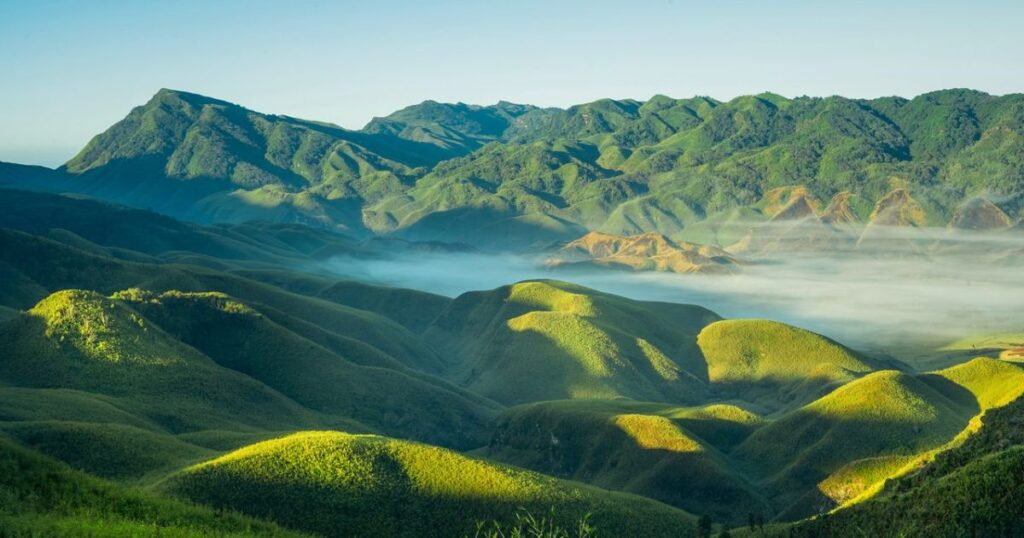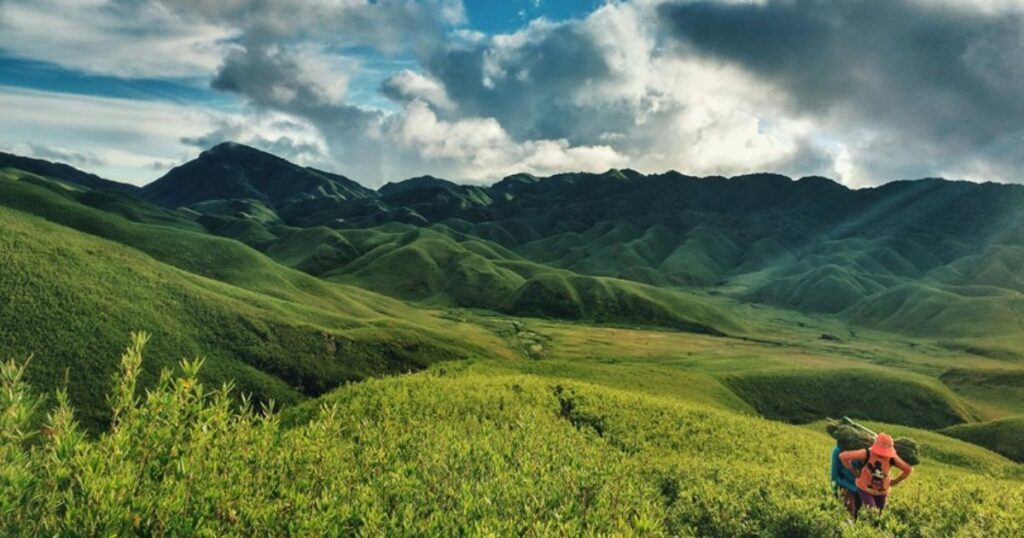Nestled between Nagaland and Manipur at an altitude of 2,452 meters, Dzukou Valley stands as one of Northeast India's most enchanting destinations. Finding the best time to visit Dzukou Valley is crucial as this pristine landscape transforms dramatically with each passing season, offering visitors completely different experiences throughout the year. From snow-covered winter wonderlands to vibrant summer meadows carpeted with rare blooms, determining the best time to visit Dzukou Valley ensures you'll experience its magic in full glory.
Table of Contents
The Mystical Dzukou Valley: A Land of Legend and Natural Wonder
The name "Dzukou" comes from the Angami Naga word meaning "cold water," referring to the ice-cold streams that flow through the valley. For centuries, this remarkable landscape has held profound cultural significance for the Angami and Southern Naga tribes who consider it a sacred sanctuary. According to local legend, the valley was formed when a divine being rested there, and the Dzukou Lily sprung from their footprints.
This remarkable valley isn't just a destination - it's a living ecosystem that changes dramatically with each season, offering visitors completely different experiences throughout the year. Knowing the best time to visit Dzukou Valley is essential for experiencing the magic that best suits your interests.
Best Time to Visit Dzukou Valley : Quick Overview
Understanding the valley's distinctive seasonal patterns is crucial for planning your perfect visit. Each month brings dramatic transformations to the landscape, accessibility, and overall experience. The Southern Angami Youth Organization (SAYO), which oversees and protects the valley, recommends different visiting periods based on travelers' interests and trekking experience. Below is a comprehensive seasonal breakdown to help you determine when to plan your journey based on your specific interests and comfort level.
| Season | Months | Temperature | Trail Condition | Flowering Status | Best For | Difficulty |
| Early Spring | Mar-Apr | 5-18°C | Moderately dry | Early blooms, rhododendrons | Nature awakening, fewer crowds | Moderate |
| Pre-Monsoon | May-Jun | 10-24°C | Mostly dry | Peak Dzukou Lily bloom | Flower photography, comfortable trekking | Easy to Moderate |
| Monsoon | Jul-Sep | 13-22°C | Wet, slippery | Maximum diversity | Serious flower enthusiasts, lush landscapes | Moderate to Difficult |
| Autumn | Oct-Nov | 5-18°C | Dry, excellent | Post-flowering, fall colors | Photography, best trekking conditions | Easy to Moderate |
| Winter | Dec-Feb | -3-12°C | Snow-covered, icy | Dormant | Snow landscapes, solitude | Difficult |
You can also explore our affordable Meghalaya Tour Package designed for Budget Travellers.
Best Time to Visit Dzukou Valley : Perfect Month
The ideal best time to visit Dzukou Valley depends entirely on what experience you're seeking. The valley offers two distinct prime seasons that showcase its most accessible and breathtaking aspects. When planning your visit, understanding these seasonal variations will help you select the perfect best time to visit Dzukou Valley based on your interests.

1. October to November:
Autumn brings what many experienced trekkers consider the absolute best time to visit Dzukou Valley. During October and November, the weather stabilizes with clear, dry days that provide exceptional visibility across the entire valley. Daytime temperatures hover comfortably between 8°C and 18°C – perfect for extended exploration without the discomfort of summer heat or winter chill.
What makes this season truly special is the combination of ideal trekking conditions with stunning visual beauty. The bamboo groves that dot the valley transition into golden hues, creating a warm contrast against the deep green meadows. Trails are predominantly dry and firm, offering excellent grip even for beginner trekkers. Photography enthusiasts particularly treasure this time for the magical golden hour lighting that bathes the landscape each morning and evening.
Key highlights of the autumn season:
- Exceptional trail conditions with dry, stable paths
- Crystal clear visibility for panoramic photography
- Comfortable temperatures (8-18°C daytime)
- Golden bamboo contrasting with green meadows
- Fewer tourists compared to flowering season
- Spectacular sunrises with mist formations in the valley
An interesting fact many don't realize: Dzukou Valley in autumn sometimes experiences a phenomenon locals call "cloud rivers," where morning mist flows through the valley contours like slow-moving rivers of cloud, creating otherworldly photographic opportunities.
2. May to June:
The second premium season arrives in late spring and early summer. From May through June, the valley awakens with vibrant life as the famous flowering season in Dzukou Valley begins. This period offers a perfect balance of accessibility and natural beauty, with warm days, generally clear mornings, and only occasional afternoon showers.
The undisputed star of this season is the Dzukou Lily (Lilium chitrangadae), an endemic species found nowhere else on Earth. This spectacular white flower with pink tinges begins blooming in late May, reaching its peak in June. Beyond this iconic lily, the valley's meadows transform into a natural garden with rhododendrons, wild orchids, and anemones creating a colorful tapestry across the landscape.
Prime attractions during flowering season:
- Endemic Dzukou Lily in full bloom (June)
- Mild, pleasant weather before monsoon intensity
- Colorful wildflower carpets across valley meadows
- Rich biodiversity with increased bird and butterfly activity
- Dramatic cloud formations creating dynamic lighting
- Perfect balance of accessibility and natural beauty
Did you know? The Dzukou Lily was only scientifically documented in 2009, though local Angami Naga tribes have revered it for generations. The flower takes its scientific name from a character in Rabindranath Tagore's works.
Dzukou Valley in Monsoon and Winter: For the Adventurous Soul
While the valley welcomes visitors year-round, some seasons require more preparation and experience.
1. Monsoon Season (July to September)
July marks the peak flowering season in Dzukou Valley, with maximum floral diversity turning the valley floor into a living painting of colors. Over 30 species of wildflowers bloom simultaneously, creating arguably the most visually stunning period in the valley's annual cycle. However, this natural spectacle comes with challenges – regular rainfall makes trails slippery and occasionally dangerous, requiring proper equipment and experienced guides.
The monsoon transforms the valley's gentle streams into rushing waterways, and the entire landscape takes on a vibrant, almost ethereal quality under the frequently dramatic skies. For serious photography enthusiasts and flower lovers willing to brave the conditions, the rewards are incomparable.
2. Winter Wonder (December to February)
Winter brings a completely different Dzukou Valley experience. From late December through February, snowfall in Dzukou Valley transforms the landscape into a pristine white wonderland that few tourists ever witness. Temperatures drop significantly, often falling below freezing at night, creating challenging but rewarding conditions for experienced trekkers.
The snow-covered meadows, frozen streams, and frost-covered dwarf bamboo create a serene, almost meditative landscape unlike anything seen in the warmer months. On clear winter days, visibility extends dramatically, offering spectacular panoramic views of the surrounding Naga Hills.
A fascinating winter phenomenon: The valley sometimes experiences "frost flowers" – delicate ice formations that bloom from plant stems in freezing conditions, creating natural ice sculptures that disappear with the morning sun.
Trek Routes to Dzukou Valley: Choosing Your Path

Understanding the Dzukou Valley trek distance and difficulty is essential for planning your journey. Three main routes lead to this hidden paradise, each offering different experiences.
The Viswema Route is the most popular and accessible path, covering approximately 8-10 kilometers one-way with a moderate difficulty level. Beginning at Viswema Village, about 25 kilometers from Kohima, this trail features well-maintained stone steps for the first 2 kilometers (the most challenging section). After this initial climb, the path levels into a more gradual forest trail before opening to stunning valley views. The trek typically takes 3-4 hours for the ascent, depending on fitness levels and weather conditions.
For those seeking a more natural experience, the Jakhama Route offers a slightly more challenging alternative. This 8-kilometer trail passes through beautiful bamboo groves and provides more varied landscapes throughout the climb. Local photography enthusiasts often prefer this route for its unique vantage points, though the steeper sections require more careful navigation.
The least traveled option is the Mao Route from Manipur, spanning approximately 15 kilometers one-way. This challenging trail requires about 6-7 hours of trekking but rewards adventurous souls with pristine wilderness experiences and perspectives of the valley that most visitors never see.
1. The Viswema Route
The most popular and accessible path, covering approximately 8-10 kilometers one-way with a moderate difficulty level. Beginning at Viswema Village, about 25 kilometers from Kohima, this trail features well-maintained stone steps for the first 2 kilometers (the most challenging section). After this initial climb, the path levels into a more gradual forest trail before opening to stunning valley views. The trek typically takes 3-4 hours for the ascent, depending on fitness levels and weather conditions.
2. The Jakhama Route
For those seeking Best Time to Visit Dzukou Valley a more natural experience, this route offers a slightly more challenging alternative. This 8-kilometer trail passes through beautiful bamboo groves and provides more varied landscapes throughout the climb. Local photography enthusiasts often prefer this route for its unique vantage points, though the steeper sections require more careful navigation.
3. The Mao Route
The least traveled option from Manipur, spanning approximately 15 kilometers one-way. This challenging trail requires about 6-7 hours of trekking but rewards adventurous souls with pristine wilderness experiences and perspectives of the valley that most visitors never see.
Route Comparison: Key Features to Consider
Each trek route to Dzukou Valley offers unique advantages and challenges. Understanding these differences will help you select the path that best matches your experience level, time constraints, and desired experience. Local guides recommend choosing your route strategically based on your priorities—whether you value convenience, photography opportunities, or wilderness immersion.
- Viswema Route: Best for first-time visitors and those prioritizing comfort; well-established rest stops
- Jakhama Route: Ideal for photographers seeking unique perspectives; more intimate with nature
- Mao Route: Perfect for experienced trekkers who value solitude and raw wilderness experiences
Pro Tips for a Successful Trek:
The peak flowering season in Dzukou Valley is from late June to early August, with the famous Dzukou Lily typically blooming from mid-June to July. However, various wildflowers can be seen from April through September, with each month offering different blooms.
- Start early (6-7 AM) to reach the valley with ample daylight hours for exploration
- Pace yourself during the initial climb, which is the steepest section on all routes
- Carry at least 2 liters of water per person, regardless of season
- Take a 10-minute break every hour to prevent fatigue
- Pack layers even in summer - temperatures can drop unexpectedly in higher elevations
While planning the best time to visit Dzukou Valley, many travelers also explore other spectacular destinations in Northeast India. If you're coming from western India, consider checking out Frenzy Holidays' Meghalaya tour packages from Mumbai, which can be perfectly combined with your Dzukou Valley adventure for a comprehensive Northeast experience.
What to Pack: Essential Gear Checklist
Proper preparation is crucial for enjoying Dzukou Valley safely and comfortably. The valley's remote location, variable weather conditions, and limited access to supplies make it essential to pack thoughtfully. Based on feedback from experienced trekkers and local guides, we've compiled this comprehensive packing list to ensure you're well-equipped for your adventure, regardless of when you visit.
For All Seasons
- Sturdy, waterproof hiking boots with ankle support
- Moisture-wicking base layers (2-3 sets)
- Quick-dry hiking pants
- Long-sleeve shirts for sun/insect protection
- Quality backpack (30-40L) with rain cover
- Trekking poles (highly recommended for steep sections)
- Headlamp with extra batteries
- Water bottles (minimum 2L capacity)
- Basic first aid kit with personal medications
- Energy-dense snacks and emergency food
- Biodegradable toiletries and toilet paper
- Valid ID and permits
- Power bank for electronic devices
- Camera with extra battery
Additional Seasonal Items
The valley's climate varies dramatically throughout the year, requiring specialized gear for different seasons. Here's what you'll need beyond the basics depending on when you visit:
Spring/Summer (April-June)
- Lightweight rain jacket
- Sun hat and sunglasses
- Insect repellent (essential)
- Sunscreen (SPF 30+)
- Light fleece for evening chill
Monsoon (July-September)
During the wettest months, moisture management becomes critical. These items will help you stay relatively dry and comfortable:
- Full waterproof gear (jacket and pants)
- Extra set of dry clothes in waterproof bag
- Leech socks or tobacco powder (natural leech repellent)
- Quick-dry towel
- Waterproof cover for all electronics
Autumn (October-November)
The temperature fluctuations of autumn require adaptable clothing options:
- Warm layer for mornings/evenings
- Gloves and light hat for early mornings
- Polarizing filter for cameras (enhances autumn colors)
Winter (December-February)
Winter trekking demands serious thermal protection. Don't underestimate the cold at this elevation:
- Insulated down jacket
- Thermal base layers
- Waterproof insulated gloves
- Warm hat covering ears
- Neck gaiter or scarf
- Thermal socks (2-3 pairs)
- Microspikes for icy conditions
- Thermos for hot beverages
Also you can check out our blog about the historical places in meghalaya so that it can help you find the best places on your next trip.
Conclusion
Planning the ideal visit to Dzukou Valley requires careful consideration of your personal preferences, trekking experience, and desired natural experiences. Each season transforms this remarkable landscape in unique ways, offering distinctly different adventures for travelers.
The best time to visit Dzukou Valley ultimately depends on what you seek from this remarkable destination. For comfortable trekking conditions and spectacular autumn colors, October and November stand unmatched. For flower enthusiasts determined to witness the famous Dzukou Lily, late May through June offers the perfect balance of accessibility and blooming beauty. Adventure seekers might brave the monsoon for peak floral diversity or winter for snowscapes few visitors ever witness.

Frenzy Holidays ensures a smooth and enriching travel experience from start to finish. You can visit us at Haware Centurion, S07/34, Nerul East, Sector 19A, Nerul, Navi Mumbai, Maharashtra 400706. For bookings or more information, call +91 7400453140, email [email protected], or visit www.frenzyholidays.com. So pack up and explore INDIA with frenzy holidays to have an unforgettable journey.
Best Time to Visit Dzukou Valley- FAQ's
When is the Best Time to Visit Dzukou Valley to see flower?
The peak flowering season in Dzukou Valley is from late June to early August, with the famous Dzukou Lily typically blooming from mid-June to July. However, various wildflowers can be seen from April through September, with each month offering different blooms.
Best Time to Visit Dzukou Valley during winter?
Yes, Dzukou Valley can be visited in winter (December-February), when it often experiences snowfall. However, winter treks require proper equipment, warm clothing, and experienced guides due to sub-zero temperatures and challenging trail conditions.
How difficult is the Dzukou Valley trek?
The difficulty varies by route and season. The Viswema route (most popular) is rated moderate with 3-4 hours of climbing. During dry seasons (October-November), it's suitable for reasonably fit beginners, while monsoon and winter seasons significantly increase difficulty.
What permits are required to visit Dzukou Valley?
Indian nationals don't require special permits but must pay entry fees (₹100). Foreign nationals need an Inner Line Permit (ILP) to enter Nagaland, which can be obtained online at ilp.nagaland.gov.in or from government offices in major cities.
Are there accommodation options in Best Time to Visit Dzukou Valley?
Yes, there's a basic rest house operated by the Southern Angami Youth Organization in the valley, offering dormitory-style accommodation for about ₹300 per night. Camping in designated areas is also permitted (₹500 permit per tent). Both options have very basic facilities.
How do I reach Dzukou Valley from major cities?
The nearest airports are Dimapur (Nagaland) and Imphal (Manipur). From either city, you'll need to reach Kohima (from Dimapur) or Mao Gate (from Imphal) by road, then take local transport to the trailheads at Viswema, Jakhama, or Mao.
What is the total cost of a Dzukou Valley trek?
For a 2-day trek including transportation from Kohima, guide fees, accommodation, food, and permits, budget approximately ₹4,000-6,000 per person for a basic experience. Organized packages with better amenities cost ₹6,000-12,000 depending on services and duration.
Is mobile network available in Dzukou Valley?
No reliable mobile network is available in the valley itself. The last dependable coverage is at Viswema/Jakhama villages. Some sporadic BSNL signals might be available at certain high points in the valley
Can I do a day trek to Dzukou Valley?
While technically possible from the Viswema route, a day trek is extremely rushed and not recommended. You would miss the valley's prime attractions and the magical early morning views. A minimum one-night stay is strongly advised.
Is it Best Time to Visit Dzukou Valley for a solo travelers?
Solo trekking is not recommended for safety reasons. The trails can be confusing, weather can change rapidly, and emergency assistance is limited. Always trek with companions or join organized groups, particularly during monsoon and winter seasons.

